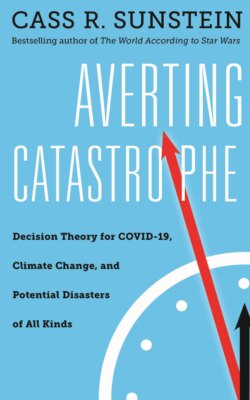Читать книгу Averting Catastrophe - Cass R. Sunstein - Страница 10
На сайте Литреса книга снята с продажи.
Doctors
ОглавлениеTo see how to approach options in the face of serious gaps in information, let us turn to a very different kind of case. Imagine that you have a heart condition but that you would like to continue doing strenuous exercise. Perhaps you play tennis. You ask your doctor for advice, and she says that you probably should not play tennis, pointing to the risk of some kind of heart damage, which would in turn increase the risk of a stroke or a heart attack. Suppose that you ask her to assign probabilities to the range of possibilities, from “no adverse health effects at all” to “death.” Suppose that she answers, “Okay, you’ve got me! The likelihood of no adverse health effects is very high—probably more than 99%. The likelihood of adverse health effects is in the vicinity of 1%, probably less. The likelihood of death, as a result of the strenuous exercise that you propose, is trivially small.”
Under such circumstances, you may or may not continue playing tennis. An important question is how much you like doing it. You might want to weigh the psychological and other benefits of playing tennis (including how much fun it is to do it) against the very small chance of significantly increasing your health risks. The outcome of that weighing will depend on your preferences—on what you enjoy or care about. If you do not much enjoy tennis, you might decide, on precautionary grounds, to stop doing it. If tennis is something that much matters to you, you might continue. Things will get more complicated if your doctor adds, parenthetically, that if you continue to play tennis, there is some chance that you will get significant health benefits and thus reduce the risk of death. (The COVID-19 pandemic offers many examples of problems of this kind, as, for example, when people resume certain activities, increasing health risks.)
Now suppose, instead, that in response to your request that she assign probabilities to the various outcomes, she says, “I can’t do that! No doctor can. For you, we just don’t know enough about the likelihood of any of the outcomes, including the bad ones.” What should you do? It would be reasonable to think: I really need to get another doctor! Surely one of them has more information than that. Surely someone knows something about the probabilities.
That would be a reasonable thought. But let us assume that the doctor is saying that this is a situation of Knightian uncertainty, in which, it will be recalled, probabilities cannot be assigned to various outcomes. Under such circumstances, some people would be drawn to the maximin principle: Adopt an approach that eliminates the worst-case scenario. With respect to pandemics, climate change, and regulation of new technologies, the same might be true. At least when some risk or technology has a terrible or catastrophic worst-case scenario, the best course might be to avoid it (depending on the costs and consequences of doing that).
Consider a real-world case encountered by a friend of mine. He has a mild heart condition. His doctor told him that his annual risk of a stroke is about 1.3%. If he goes on a medication, he can cut that risk to under 1%. (How much under? The science does not say.) But the medication itself creates a risk of serious complications—not nearly as serious as a stroke, but serious. What is the magnitude of that risk? The science suggests that it is under 1%. (How much under? The science does not say.) The doctor recommended that my friend go on the medication, using something like the maximin principle: A stroke is the worst-case scenario, and it should be avoided. My friend declined, on the theory that the trouble of taking a pill every day, combined with the risk of serious complications, exceeded the (small) benefit of reducing a stroke risk by just 4 in 1,000 (or perhaps a bit more). In my view, the doctor was reasonable in suggesting that my friend follow the maximin principle—but my friend was also reasonable in declining to do so.
